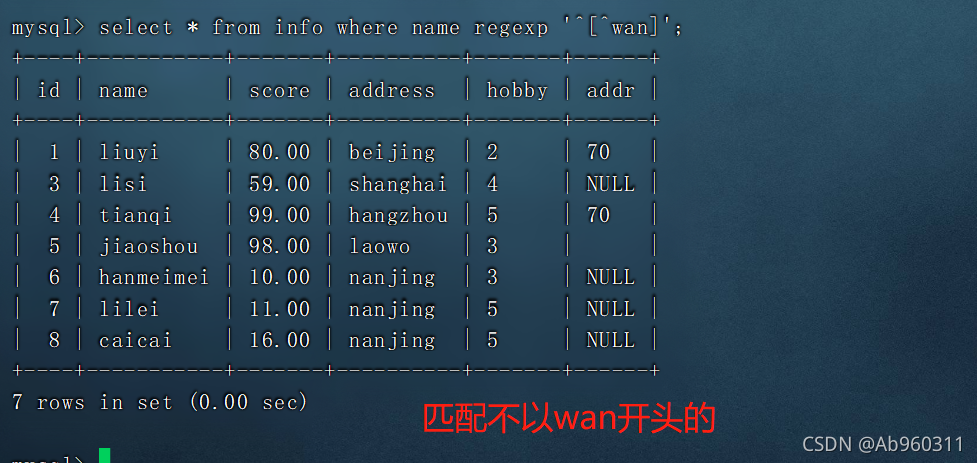当前位置:网站首页>Mysql database explanation (8)
Mysql database explanation (8)
2022-04-23 15:19:00 【C chord~】
Catalog
2.2 It's not equal to (!= or <>)
2.3 Greater than 、 Greater than or equal to 、 Less than 、 Less than or equal to
2.4 Judge a value as / Not for null(is null,is not null)
2.5 Between the two (between … and …)
2.7 stay / Not in the assembly (in/not in)
One . Regular expressions
- MysQL Regular expressions are usually used when retrieving database records , Match the special string in the record that meets the requirements according to the specified matching pattern .
- MysQL Regular expressions for use REGEXP Use this keyword to specify the matching pattern of the regular expression
Matching mode describe
^ Match the start character of the text
$ Match the end character of the text
. Match any single character
* Match zero or more characters before it
+ Match preceding characters 1 Times or times
character string Match contains the specified string
p1Ip2 matching p1 or p2
[…] Match any character in the character set
[^…] Match any characters that are not in brackets
{n} Match the previous string n Time
{n,m} Match the previous string at least n Time , at most m Time
Don't talk much , Last case

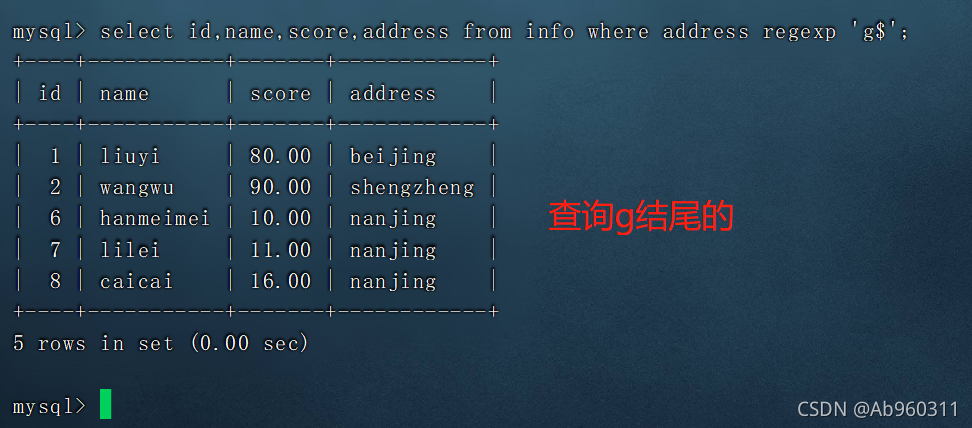
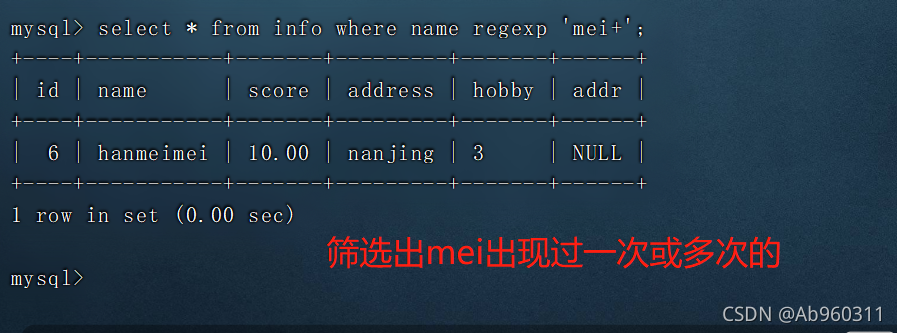
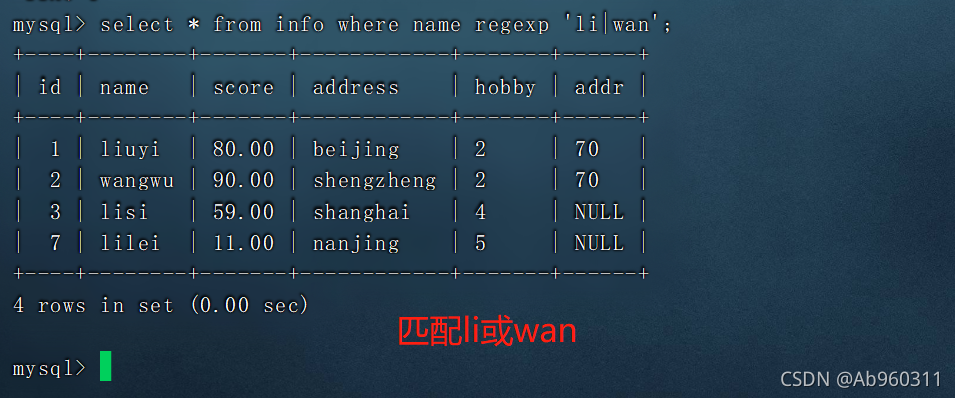
Two . Operator
- MysQL There are four kinds of operators , Namely : Arithmetic operator 、 Comparison operator 、 Logical and bitwise operators .
1. Arithmetic operation
Operator describe
+ Add
- Subtraction
* Multiplication
/ division
% Remainder
In Division , The divisor cannot be zero 0, If the divisor is 0, The result returned is null .
If there are multiple operators , According to the priority of multiplication and division before addition and subtraction , Operations of the same priority , There is no order 
2. Comparison operations
Common comparison operators explain
= be equal to
!= or <> It's not equal to
> Greater than
>= Greater than or equal to
< Less than
<= Less than or equal to
is null Judge whether it is null
is not null Judge whether it is not null
between and Between the two
greatest Returns the maximum value when two or more parameters
least Returns the minimum value when two or more parameters
in In the assembly 2.1 be equal to (=)
Equal sign (=) To judge numbers 、 Whether the string and expression are equal , If equal, return 1, Returns if not equal 0.
If one of the two values compared is NULL, The result of the comparison is NULL.
The comparison of characters is based on ASCII Code to judge , If ASCIl The code is equal , It means that the two characters are the same ; If ASCII The codes are not equal , It means that the two characters are different . Like strings ( Letter ) Compare : (‘a’ > ‘b’) In fact, the comparison is the bottom ASCll Code needs attention ASCII The code has :a、A、0
summary : Conditional return 1, Not established to return 0, Yes null return null

2.2 It's not equal to (!= or <>)
- Used for numbers 、 Comparison of unequal strings and expressions , Returns if not equal 1, If equal, return 0
- It's not equal to (!=,<>) Cannot be used to determine whether it is null
summary : Set up return 1, Not established to return 0, Yes null return null

2.3 Greater than 、 Greater than or equal to 、 Less than 、 Less than or equal to
- Greater than (>) Operator is used to determine whether the operand on the left is greater than the operand on the right , If greater than, return 1, Otherwise return to 0, Also cannot be used to judge NULL
- Less than (<) Operator is used to determine whether the operand on the left is less than the operand on the right , If less than, return 1, Otherwise return to 0, Also cannot be used to judge NULL
- Greater than or equal to (>=) Judge whether the operand on the left is greater than or equal to the operand on the right , If greater than or equal to, return 1, Otherwise return to 0, Cannot be used to judge NULL
- Less than or equal to (<=) Judge whether the operand on the left is less than or equal to the operand on the right , If less than or equal to, return 1, Otherwise return to 0, Cannot be used to judge NULL
summary : Conditional return 1, Not established to return 0, Yes null return null
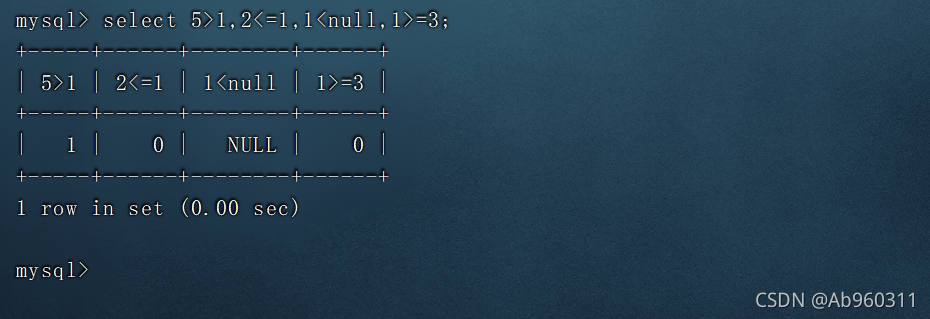
2.4 Judge a value as / Not for null(is null,is not null)
- IS NULL Determines whether a value is NULL, If NULL return 1, Otherwise return to 0
- IS NOT NULL Judge whether a value is not NULL, If not for NULL return 1, Otherwise return to 0
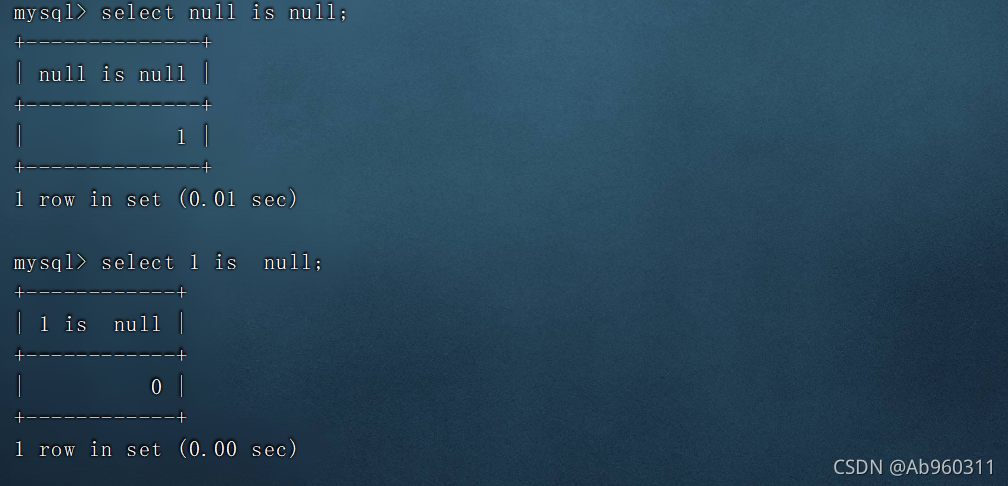
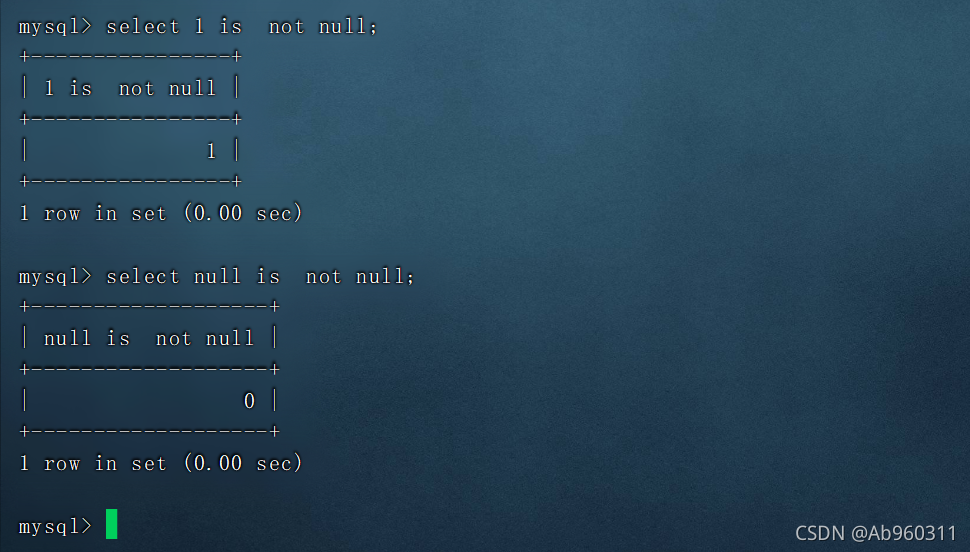
2.5 Between the two (between … and …)
- Usually used to determine whether a value is between two values .
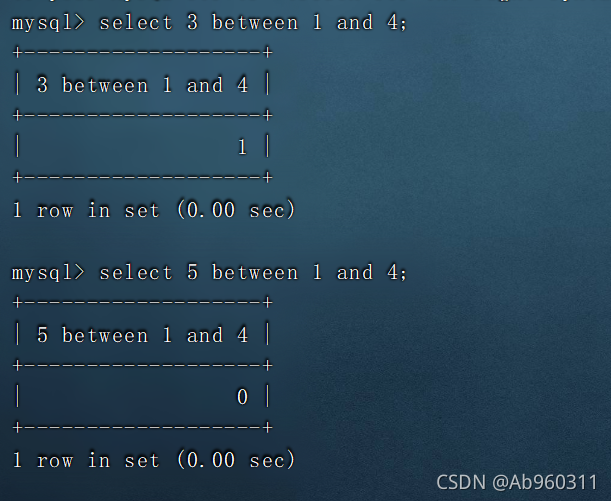
2.6 When there are two or more parameters , Returns the largest of / minimum value , If one of them is null, Then return to null(least、greatest)

2.7 stay / Not in the assembly (in/not in)
Judge a value in (in) Or not (not in) Collection , If established, return to 1, If not, return to 0
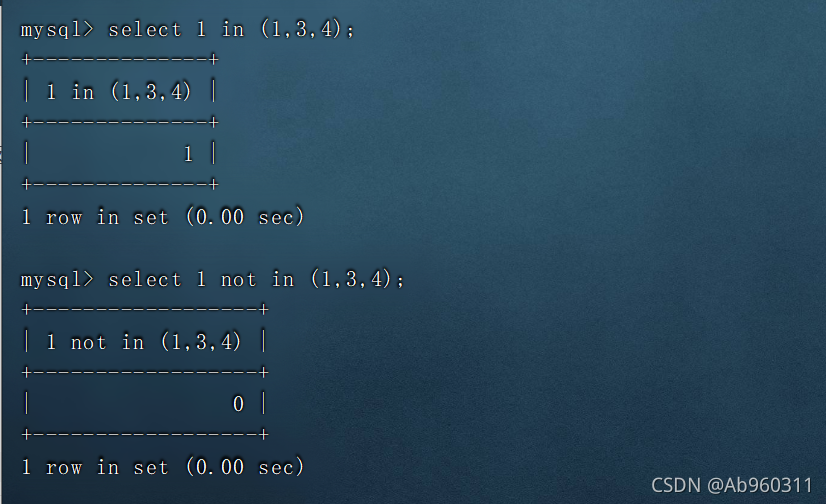
2.8 Wildcard match
- LIKE Used to match strings , If the match is successful, it returns 1, Instead, return to 0
- LIKE Two wildcards are supported :‘%’ Used to match any number of characters , and ’_' Only one character can be matched .


3. Logical operations
- Logical operators are also called Boolean operators , It is usually used to judge whether an expression is true or false , If it is true to return 1, Otherwise return to 0, True and false can also be used TRUE and FALSE Express .
- MySQL There are four logical operators supported in
Operator describe
not or ! Logic is not
and or && Logic and
or Logic or
xor Logical XOR 3.1 Logic is not (not or !)
- Logical non negates the value following him , If NOT The following operands are 0 when , The results are as follows 1
- If the operand is not 0 when , The results are as follows 0
- If the operand is NULL when , The results are as follows NULL
- summary : The following value is not 0 Then return to 0, by 0 Then return to 1, by null Then return to null

3.2 Logic and (and or &&)
- When all operands are non-zero and not NULL when , The return value is 1
- When one or more operands are 0 when , The return value is 0
- Any one of the operands is NULT when , The return value is NULL
- summary : All values are non-zero and not null return 1, Yes null Then return to null, Otherwise return to 0.
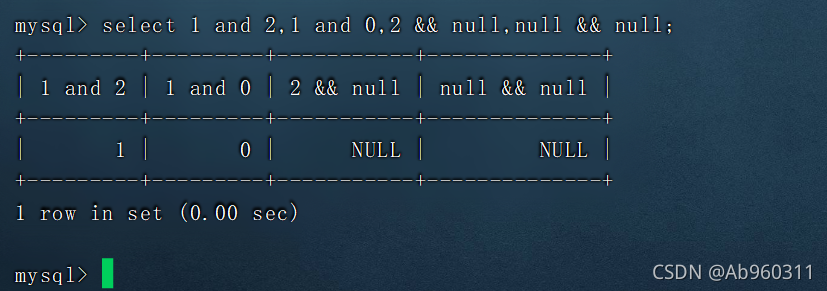
3.3 Logic or (or)
- When both operands are not NULL When the value of , If any of the operands is nonzero , The return value is 1, Otherwise, the result is 0
- When one of the operands is NULL when , If the other operand is nonzero , The return value is 1, Otherwise, the result is NULL
- Suppose both operands are NULL when , The return value is NULL.
- summary : One of the operands is not 0 And not for null Then return to 1, All for null Then return to null

3.4 Logical XOR (xor)
- When any one of the operands is NULL when , The return value is NULL
- For non NULL The number of operations , If both operands are not 0 Value or both 0 value , The return value is 0
- If one is for 0 value , The other is not 0 value , The return value is 1
- summary : There is... In any one of the operands null、 return null, None of the operands are 0 Or both 0 When to return to 0, There is only one for 0 When to return to 1

4、 An operator
- Bit operators are operators that evaluate on binary numbers
- Bit operations first convert operands into binary numbers , Do bit operations
- Then change the result from binary to decimal
An operator describe
& Bitwise AND
I Press bit or
^ Bitwise XOR
! Take the opposite
<< Move left
>> Move right summary : Bit operators need to be converted to binary for calculation
Bitwise AND (&):1*1 have to 1, otherwise 0
Press bit or (|): Yes 1 Of 1, otherwise 0
Bitwise XOR (^): Different 1, otherwise 0
According to the not (~): Take the opposite first , after 1*1 have to 1, otherwise 0
5. priority
!
~
^
*、/、%
+、-
<<、>>
&
|
=、<=>、>=、>、<=、<、<>、!=、like、regexp、in
between、case、when、then、else
not
&&、and
or、xor
:=3、 ... and .. Link query
- MysQL Connection query for , It's usually a combination of rows from two or more tables , Based on the common fields between these tables , Data splicing .
- First , To determine a primary table as the result set , Then selectively connect the rows of other tables to the selected main table result set .
- More frequently used join queries include : Internal connection 、 Left connection and right connection
1、 Internal connection
grammar
select Field from surface 1 inner join surface 2 on surface 1. Field = surface 2. Field
- MySQL An inner join in a table is a combination of data records in two or more tables that meet certain conditions at the same time .
- Usually in from Use keywords in clauses inner join To connect multiple tables , And use on Clause sets the join condition
- Internal connection is the default table connection , So in from Clause can be omitted inner keyword , Use keywords only join , When there are multiple tables at the same time , It can also be used continuously inner join To realize the internal connection of multiple tables , But for better performance , It is recommended not to exceed three tables
2、 Left connection
- The left connection can also be called the left outer connection , stay from Clause left join perhaps left out join Keyword to represent .
- The left join is based on the left table , Receive all rows of the left table , And use these lines to match the records in the reference table on the right , That is, match all rows in the left table and the qualified rows in the right table .
- Left connection , All the records in the left table will be shown , The right table will only display the records that meet the search criteria , The deficiencies are null
3、 The right connection
- The right connection is also called the right outer connection , stay from Clause right join perhaps right out join Keyword to represent .
- The right connection is the opposite of the left connection , It is based on the right table , Used to receive all rows in the right table , And use these records to match the rows in the left table
summary
For many judgments in this article, the return value can obey an atom ; Whether the command is true ( That is, whether it can achieve , Whether it conforms to common sense, such as 3>4 For false ,3<4 It's true ), If true, return to 1, False returns 0.
版权声明
本文为[C chord~]所创,转载请带上原文链接,感谢
https://yzsam.com/2022/04/202204231406064014.html
边栏推荐
- OPPO数据湖统一存储技术实践
- 如何设计一个良好的API接口?
- G007-HWY-CC-ESTOR-03 华为 Dorado V6 存储仿真器搭建
- MySQL query library size
- Design of digital temperature monitoring and alarm system based on DS18B20 single chip microcomputer [LCD1602 display + Proteus simulation + C program + paper + key setting, etc.]
- 小红书 timestamp2 (2022/04/22)
- Nacos程序连接MySQL8.0+ NullPointerException
- Leetcode149 - maximum number of points on a line - Math - hash table
- T2 iCloud日历无法同步
- 8.4 realization of recurrent neural network from zero
猜你喜欢

nuxt项目:全局获取process.env信息

Borui data and F5 jointly build the full data chain DNA of financial technology from code to user
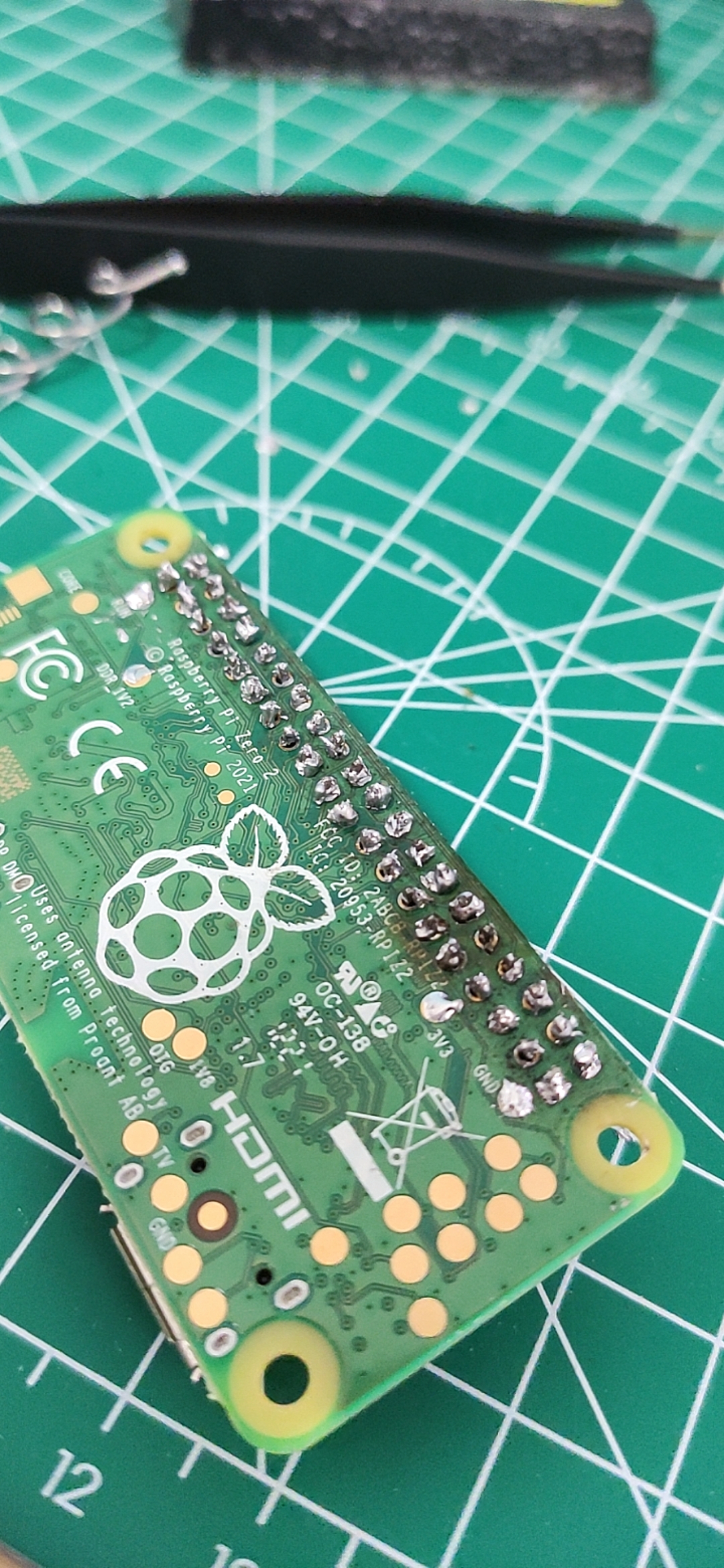
My raspberry PI zero 2W toss notes to record some problems and solutions
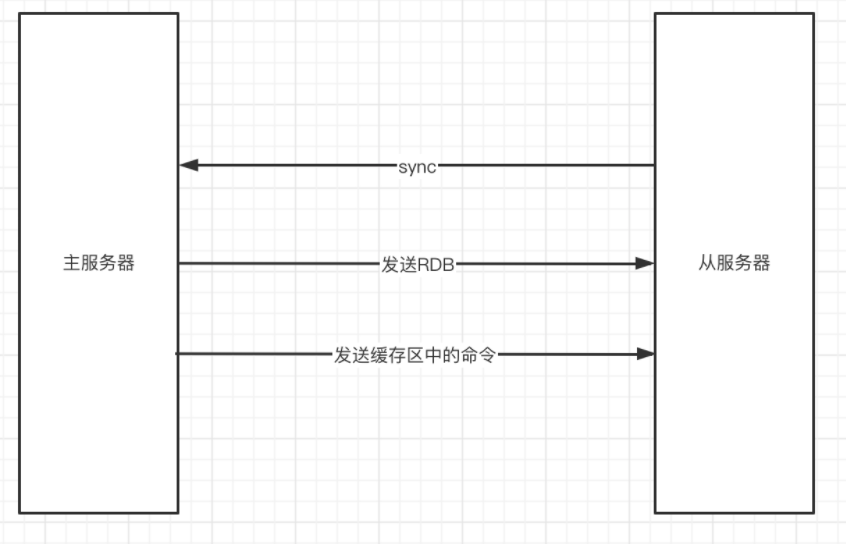
Redis master-slave synchronization

Openfaas practice 4: template operation
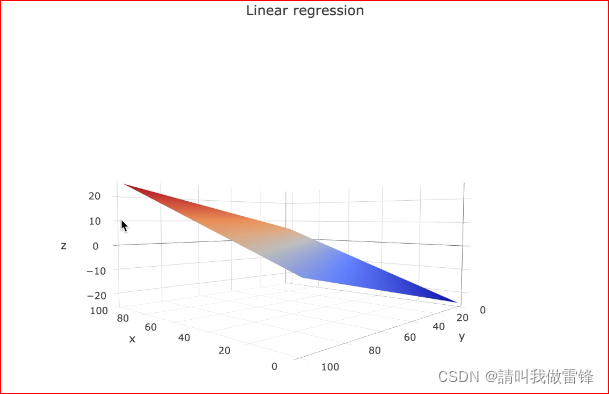
机器学习——逻辑回归

API gateway / API gateway (II) - use of Kong - load balancing
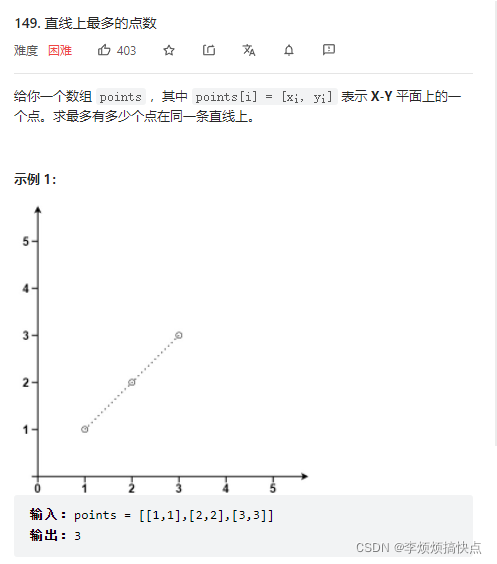
Leetcode149 - maximum number of points on a line - Math - hash table
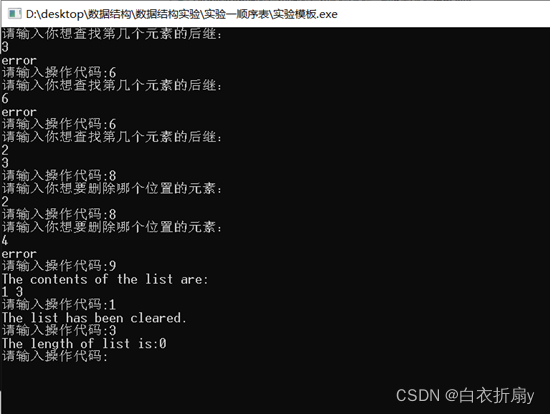
Have you really learned the operation of sequence table?
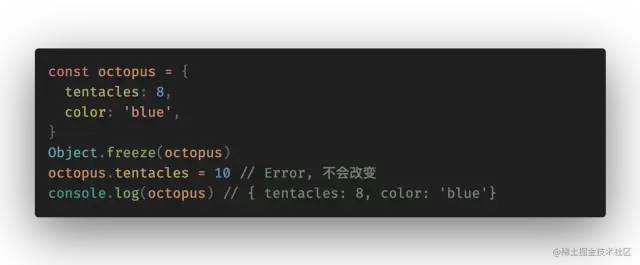
分享 20 个不容错过的 ES6 的技巧
随机推荐
js——实现点击复制功能
Educational Codeforces Round 127 A-E题解
SSH connects to the remote host through the springboard machine
Baidu written test 2022.4.12 + programming topic: simple integer problem
C language super complete learning route (collection allows you to avoid detours)
MySQL installation process (steps for successful installation)
adobe illustrator 菜單中英文對照
分享3个使用工具,在家剪辑5个作品挣了400多
Example of time complexity calculation
Practice of unified storage technology of oppo data Lake
nuxt项目:全局获取process.env信息
JUC学习记录(2022.4.22)
免费在upic中设置OneDrive或Google Drive作为图床
LeetCode151-颠倒字符串中的单词-字符串-模拟
Detailed explanation of kubernetes (IX) -- actual combat of creating pod with resource allocation list
January 1, 1990 is Monday. Define the function date_ to_ Week (year, month, day), which realizes the function of returning the day of the week after inputting the year, month and day, such as date_ to
重定向和请求转发详解
Sword finger offer (2) -- for Huawei
Precautions for use of dispatching system
Detailed explanation of kubernetes (XI) -- label and label selector
